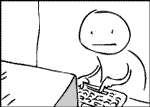Math Shortcuts
Posted by MaNi on August 9, 2008
Squaring of Two numbers
Consider a simple example 92
Step 1: Consider the nearest base (here 10).
Step 2: As 9 has a deficiency of 1 (10 – 9 = 1), we should decrease it further by 1, and set down our LHS of the Answer as ‘8’.
Step 3: On the RHS put the square of the deficiency (here 1).
We get 92 = 81.
Now Consider 102
1) Base is 100
2) Deficiency is ‘-2’ (100 – 102 = -2)
Therefore we subtract ‘-2’ from 102
102 – (-2) = 104
This is our RHS
3) Our LHS now becomes (-2)2 which is 4
Since the base is 100 we write it as ’04’, so that we get 1022 = 10404
For multiplication also we use the same technique
Consider 282
1) Let 20 be the Working Base and 10 as the Main Base.
Therefore x = (Main Base)/ (Working Base) = 10/20 = 1/2
2) Here the deficiency = 20 – 28 = -8
Therefore RHS = 28 – (-8 ) = 36
Divide by x i.e. by (1/2).
We get 36/ (1/2) = 72. This is the required RHS.
3) LHS = (-8 )2 = 64
Since Main Base is 10, we put only ‘4’ on the LHS and carry over ‘6’ to the RHS
Therefore we get
282 = 72+6 | 4 == 784
Some More Examples
362 = 128 |1 6 = 1296 (Base = 40)
522 = 27 | 04 = 2704 (Base = 50)
9972 = 994 | 009 = 994009 (Base = 1000)
10042 = 1008 | 016 = 1008016 (Base =1000)
This technique exclusively for numbers ending with 5
For numbers ending with 5 the LHS will be 25.
The RHS will be the product of the other digits….
Examples:
252 = (2 * 3) | 25 = 625
352 = (3 * 4) | 25 = 1225
452 = (4 * 5) | 25 = 2025
552 = (5 * 6 ) | 25 = 3035
652 = (6 * 7) | 25 = 4225
752 = (7 * 8 ) | 25 = 5625
1052 = (10 * 11) | 25 = 11025
1252 = (12 * 13) | 25 = 15625
1752 = (17 * 18 ) | 25 = 30625
‘duplex combination’ can be used for general purpose squaring.
To proceed further we need to know the formula for certain numbers.
D( a ) = a2
D( ab ) = 2ab
D( abc ) = 2ac + b2
D( abcd ) = 2ad + 2bc
D( abcde ) = 2ae + 2bd + c2
D( abcdef ) = 2af + 2be + 2cd and so on….
As we can see above, D of any number is the sum of square of the middle number and two times the product of the other pairs.
Square of a number is given by
( ab )2 = D( a ) | D( ab ) | D( b )
( abc )2 = D( a ) | D( ab ) | D(abc) | D( bc ) | D( c )
( abcd )2 = D(a) | D(ab) | D(abc) | D(abcd) | D(bcd) | D(bc) | D (c)
Example :
(23)2 = (ab)2 = D(a) | D(ab) | D(b)
= 4 | 12 | 9
Since this technique must have only one digit, we carry over ‘1’ of ’12’ to LHS.
Therefore it becomes 4 |1 2| 9
Hence the answer is 529
Example 2:
(527)2 = ( abc )2
= D( a ) | D( ab ) | D(abc) | D( bc ) | D( c )
= 25 | 20 | 74 | 28 | 49
= 25 |2 0 |7 4 |2 8 |4 9
= 277729
This method is similar to squaring. It is just modified a bit, as we shall see in the next few examples.
Consider 133
Step 1: Consider nearest base (here 10).
Step 2: As 13 has an excess of ‘3’ (13 – 10 = 3), we double the excess and add the original number (13) to it, and put it on the LHS.
Therefore we get 13 + 6 = 19
Step 3: Now find the new excess. In this case it is 19-10 = 9. Now multiply this with the original excess to get the middle part of the answer.
Therefore we get 9 * 3 = 27
Step 4: Now cube the original excess and put it as the last part
Carry over any big numbers and total to get the answer.
19 7 7
2 2
21 9 7
Therefore 133 = 2197
Now consider 473
1) Let the main base be 10 and the working base is 50
Therefore the ratio
x = (Main Base)/ (Working Base) = 10/50 = 1/5
2) Excess is -3 (47 – 50 = -3). Double the excess and add the original number (here 47) to it.
We get 47 – 6 = 41.
The Base correction for this part is achieved by dividing by x2 .
Therefore we get 41/ (1/25) = 41 * 25 = 1025
3) Excess in the new uncorrected number (41 – 50 = -9) is multiplied by the original excess (-3) to obtain the second part.
Therefore we get -9 * -3 = 27
The Base correction for this part is achieved by dividing by x.
Therefore we get 27 * 5 = 135
4) The third part is obtained by cubing the excess.
(-3)3 = -27
5) Carry over the extra numbers and total to obtain the final answer
1025 0 0
13 5 0
-2 7
1038 2 3
Therefore the final answer is 103823
Direct Cubing
This method is simple and easy.
If the number is ( ab ) its cube can be calculated as
a3 a2b ab2 b3
2a2b 2ab2
Sum them up taking care of the carryovers.
Consider (16)3
Writing it as above
1 6 36 216
12 72
1 18 108 216
Considering the carryovers
Therefore we get the answer as 4096….










Leave a comment